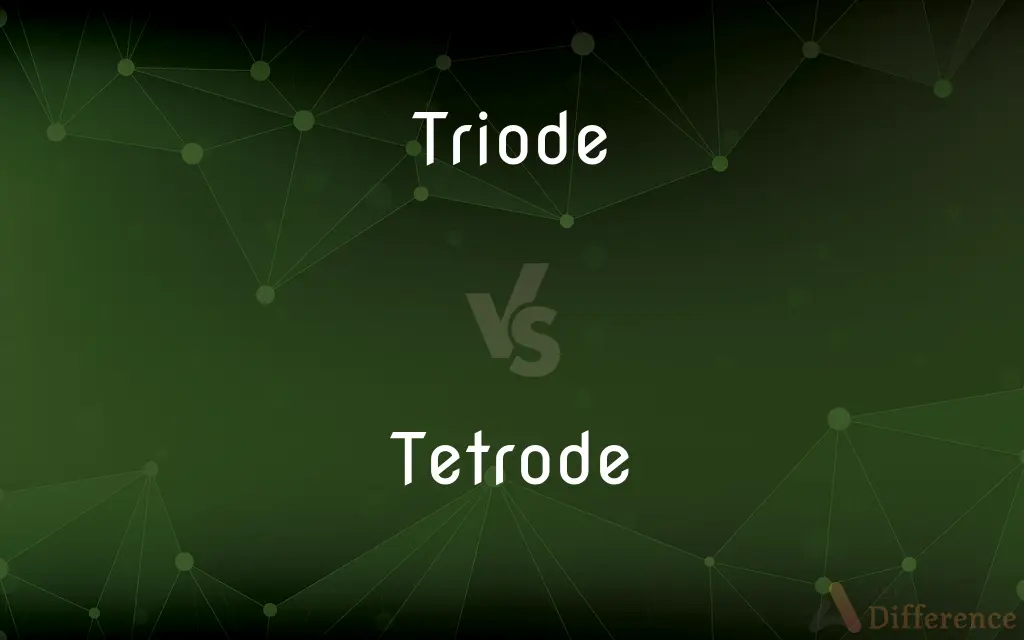Triode vs. Tetrode — What's the Difference?
By Fiza Rafique & Maham Liaqat — Updated on April 2, 2024
A triode amplifies electronic signals with three components (anode, cathode, grid), offering simpler design, whereas a tetrode, with four components (adding a second grid), provides enhanced amplification and frequency performance.

Difference Between Triode and Tetrode
Table of Contents
ADVERTISEMENT
Key Differences
A triode uses a vacuum tube design incorporating three elements: anode, cathode, and control grid, to amplify electrical signals. This structure allows for the control of electron flow from cathode to anode, effectively amplifying incoming electrical signals. On the other hand, a tetrode adds a fourth component, a second grid called the screen grid, between the control grid and the anode. This addition improves amplification and reduces the capacitance between the anode and control grid, enhancing frequency response.
The triode's simpler design means it generally has lower manufacturing costs and is easier to implement in circuits. It offers sufficient performance for a wide range of low to medium frequency applications. Conversely, the tetrode, with its additional grid, involves more complex manufacturing and design considerations. However, this complexity allows for better performance in high-frequency applications, making it suitable for radio frequency amplification and oscillation circuits.
In terms of distortion, triodes tend to produce a more harmonically rich distortion, which is often described as warmer and more musical, making them popular in audio applications. The tetrode, while offering higher gain, can sometimes introduce unwanted oscillations and distortion due to its additional elements, requiring careful circuit design to mitigate.
Feedback mechanisms in triodes are simpler to manage due to their three-element design. They are less prone to instability and are often used in applications where signal fidelity is critical. In contrast, tetrodes, due to their additional screen grid, can be more challenging to stabilize but offer the advantage of increased gain and efficiency in feedback applications, provided the design accounts for their characteristics.
Power handling is another area of difference. Triodes, while effective for a range of applications, are generally limited in their power handling capabilities compared to tetrodes. The addition of the screen grid in tetrodes allows them to handle higher voltages and currents, making them better suited for high-power applications.
ADVERTISEMENT
Comparison Chart
Components
Anode, Cathode, Control Grid
Anode, Cathode, Control Grid, Screen Grid
Amplification
Good
Better, due to reduced grid-anode capacitance
Frequency Performance
Suitable for low to medium frequency
Better suited for high-frequency
Distortion
Warmer, musical distortion
Can introduce unwanted oscillations
Power Handling
Lower
Higher, due to improved design
Compare with Definitions
Triode
A vacuum tube with three elements used to amplify signals.
The audio amplifier in vintage radios often used a triode for its warm sound.
Tetrode
Offers enhanced amplification and frequency response.
High-end radio receivers utilize tetrodes for their improved signal clarity.
Triode
Known for harmonically rich distortion.
Guitar amplifiers favor triodes for their characteristic warm tone.
Tetrode
A vacuum tube with an additional screen grid, totaling four elements.
The tetrode's design revolutionized radio transmission with its superior frequency performance.
Triode
Popular in low to medium frequency applications.
Triodes were foundational in the development of early telephone systems.
Tetrode
Can handle higher power applications.
Tetrodes are preferred in high-power radio transmitters for their efficiency.
Triode
Limited in power handling compared to tetrodes.
Triodes are less commonly found in high-power applications due to their design limitations.
Tetrode
Requires careful circuit design to avoid oscillations.
The design of tetrode circuits must account for potential instability due to the screen grid.
Triode
Features an anode, cathode, and control grid.
The simplicity of the triode makes it a staple in basic electronic circuits.
Tetrode
Suited for high-frequency applications.
Tetrodes are key components in microwave and RF amplifiers due to their performance at high frequencies.
Triode
A triode is an electronic amplifying vacuum tube (or valve in British English) consisting of three electrodes inside an evacuated glass envelope: a heated filament or cathode, a grid, and a plate (anode). Developed from Lee De Forest's 1906 Audion, a partial vacuum tube that added a grid electrode to the thermionic diode (Fleming valve), the triode was the first practical electronic amplifier and the ancestor of other types of vacuum tubes such as the tetrode and pentode.
Tetrode
A tetrode is a vacuum tube (called valve in British English) having four active electrodes. The four electrodes in order from the centre are: a thermionic cathode, first and second grids and a plate (called anode in British English).
Triode
An electron tube used mostly for signal amplification, consisting of a cathode, an anode, and an intervening wire mesh called a control grid.
Tetrode
A four-element electron tube containing an anode, cathode, control grid, and additional electrode.
Triode
A thermionic valve containing an anode, a cathode, and a control grid; small changes to the charge on the grid control the flow from cathode to anode, which makes amplification possible.
Tetrode
A thermionic valve similar to a triode with the addition of a screen grid to improve the thermionic emission.
Triode
A thermionic vacuum tube having three electrodes; fluctuations of the charge on the grid control the flow from cathode to anode which making amplification possible
Tetrode
A dynatron.
Tetrode
A dual-gate MOSFET.
Tetrode
A thermionic tube having four electrodes
Common Curiosities
How does a triode work?
A triode amplifies signals by controlling the flow of electrons from the cathode to the anode with a voltage applied to the control grid.
What is a tetrode?
A tetrode adds a fourth component, a screen grid, to the triode design, enhancing its amplification and frequency performance, especially in high-frequency applications.
How does a tetrode improve upon the triode?
A tetrode reduces capacitance between the anode and control grid with a screen grid, improving gain and frequency response.
Why might one choose a triode over a tetrode?
Triodes are chosen for their simpler design, warmer distortion, and suitability for audio and low-medium frequency applications.
Why are tetrodes preferred in high-frequency applications?
Their additional screen grid reduces unwanted capacitance, making them better suited for high-frequency amplification.
Can tetrodes handle more power than triodes?
Yes, the design of tetrodes allows them to handle higher voltages and currents, making them ideal for high-power applications.
Are there any modern advancements in triode or tetrode technology?
Advancements continue in vacuum tube technology, focusing on improving efficiency, reliability, and integration with modern electronics.
What is a triode?
A triode is a type of vacuum tube with three main components used to amplify electronic signals, popular in audio and low-medium frequency applications.
How do feedback mechanisms differ between triodes and tetrodes?
Feedback is simpler to manage in triodes due to their design, whereas tetrodes offer increased gain with more complex feedback requirements.
Is distortion a concern with tetrodes?
While tetrodes offer higher gain, they can introduce unwanted oscillations and require careful design to mitigate distortion.
Are triodes still used today?
Yes, triodes are still used, especially in audio applications for their warm, harmonically rich distortion.
How do manufacturers decide between using a triode or a tetrode?
The choice depends on the application's requirements for amplification, frequency performance, and power handling.
Do tetrodes produce a different sound quality compared to triodes?
Yes, tetrodes can produce a different quality of sound, often described as less warm due to their higher efficiency and different distortion characteristics.
What is the historical significance of triodes?
Triodes were crucial in the early development of radio, telephone systems, and audio amplification, marking a significant advancement in electronics.
Can triodes and tetrodes be used interchangeably?
While they can serve similar functions, their differences in design and performance make them better suited for specific applications.
Share Your Discovery

Previous Comparison
Task vs. Question
Next Comparison
Giveaway vs. WeaknessAuthor Spotlight
Written by
Fiza RafiqueFiza Rafique is a skilled content writer at AskDifference.com, where she meticulously refines and enhances written pieces. Drawing from her vast editorial expertise, Fiza ensures clarity, accuracy, and precision in every article. Passionate about language, she continually seeks to elevate the quality of content for readers worldwide.
Co-written by
Maham Liaqat















































